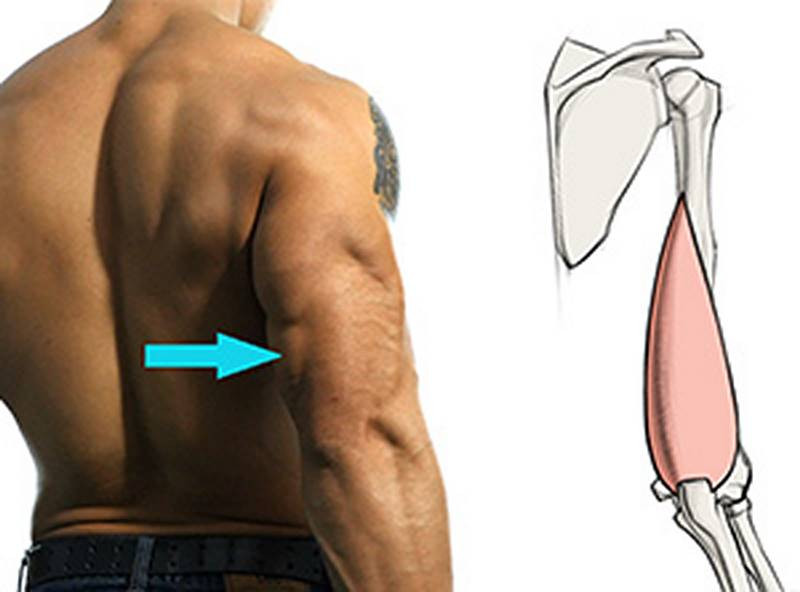In this lesson, I’ll teach you how to draw the triceps. Whether you want to draw Buff Pikachu, or something normal, triceps are an important part of the arm. The triceps have three asymmetrical heads surrounding a large, flat, tendinous zone.

The three heads are distinctly separate from each other. They’re called the medial head, the lateral head, and the long head. The medial head is the “Baby Bear” of the group. It’s mostly covered up from the back, so you only see a little bit of it. The lateral head is “Mama Bear” and it gets the entire lateral side to itself. But the long head is the biggest. It’s the “Papa Bear.” It sits above and partially on top of the medial head. Because of the long head-medial head combo on the medial side of the tendon, the triceps are asymmetrical. Most of its mass is at the inside of the arm. The three heads originate in different places, but they ALL insert along the edges of the triceps tendon, which attaches to the elbow. Or as you fancy people call it, the Olecranon of the Ulna.
About half of the triceps’ overall length is taken up by this tendon, so it’s important to understand the shape and design of the tendon as much as it is to understand the muscle heads themselves. The tendon creates a flat zone in the middle of the triceps, and the other forms bulge out around it. It’s kinda like a push-up bra for mama bear and papa bear.
When the triceps flex they straighten out the elbow, the opposite of the biceps and brachialis.
Alright, let’s take a closer look at each, starting with "Mama Bear".
Lateral Head
It originates from just below the head of the humerus to about halfway down the bone.
It inserts at the upper 2/3 of the triceps tendon, along the lateral edge. It has this distinct comma shape, with the main mass sitting above the tendon and a thin tail tapering down alongside the tendon. So, egg-shaped body, and a thin long tail.
From the side, you’ll see the round body high up on the arm and the flat tendon reaching down to the elbow.

Medial Head
Next up is the medial head.There’s something very unusual about this "Baby Bear": this muscle mass lies underneath and is protected by its tendinous blankie.
The medial head originates from a large portion of the humerus; the lower two-thirds. But in back view, it’s mostly covered up by the triceps tendon and the long head. It’s like the brachialis of the back of the arm. Remember the bologna sandwich from the previous lesson?
The medial head spills out from the sides, like the bologna in a sandwich.
The medial head inserts on the lower ⅓ of both edges of the tendon and also the interior plane of the tendon.


It’s superficial out on both sides of the tendon, but moreso on the medial side, for which it gets its name.
When seen from the inside view, more of its length is visible extending up the humerus before the long head overlaps it.
Long Head
As you might have guessed, "Papa Bear" is the largest of the three heads. It originates from the outside edge of the scapula, under the shoulder joint, close to where the biceps originate. It dives between the teres major and teres minor on its way to the scapula, but skin and fat soften this overlap, so it’s not obvious on the surface.
Also, all the origins are covered by the deltoid, so you won’t see the upper portion of the triceps.
But, I would still take note of the long head originating at the scapula so that you design your forms to point in the right direction.
The long head inserts along the upper two-thirds of the triceps tendon, on the medial side. It has a flattened, teardrop form.

There’s a weird thing that happens with the long head near the armpit. This extra piece of tendon creates a furrow when the triceps are flexed, which splits the long head in half at the upper end. It’s this wide, vertical furrow. It’s a common mistake to look at the bottom half and confuse it with the medial head. But now you know. So, you won’t make that mistake.

Tendon
Like I said before, the tendon takes up roughly half the length of the muscle, although tendon-to-muscle ratios vary between people. The tendon sits on top of the medial head, not on the humerus bone directly. It creates a large flat zone, and all the bulky heads attach around its edges.


Extra Goodies
If you enjoyed this lesson and would like to learn more in-depth Triceps content, check out the Premium Anatomy Course.
Assignment
As with the previous few lessons, your assignment is to do quicksketch drawings of the arms, focusing on the gesture and then adding the forms of the triceps. Pay attention to asymmetry of the triceps, and clearly identify the 3 heads and the tendon. I like to design the triceps using angular lines, trying to create dynamic interesting shapes. Since you’ve already mastered the biceps, brachialis, and deltoid, identify and design those too.














